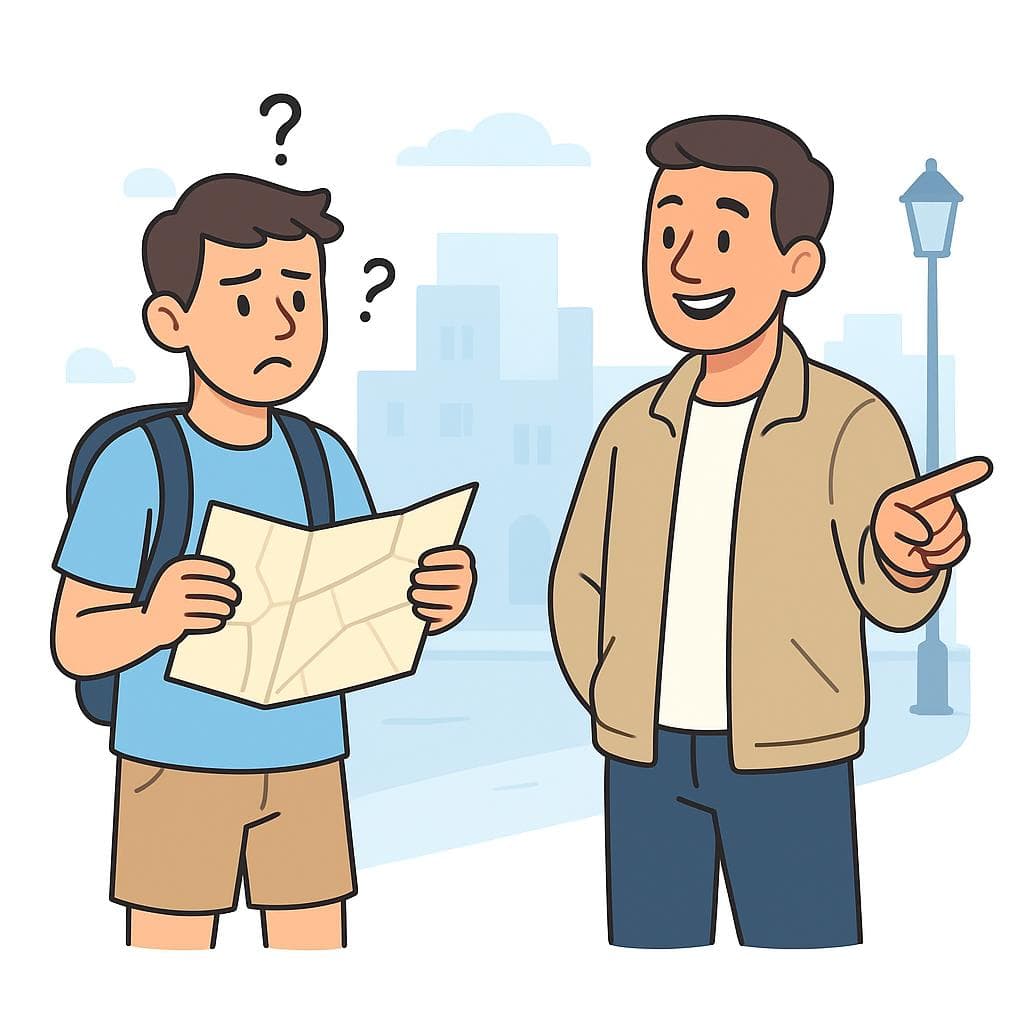I don't understand
in SpanishNo entiendo
/noh ehn-TYEHN-doh/
This is the most direct, common, and universally understood way to say 'I don't understand' in Spanish. It's your go-to phrase, suitable for almost any situation.

Feeling lost in a conversation? 'No entiendo' is your most important tool for asking for clarification and help.
💬Other Ways to Say It
No comprendo
/noh kohm-PREHN-doh/
Very similar to 'No entiendo', but can sound slightly more formal or imply a deeper lack of comprehension. 'Entender' is about hearing the words, while 'comprender' is about grasping the concept.
¿Cómo?
/KOH-moh/
This literally means 'How?' but is used constantly to mean 'What?', 'Pardon?', or 'Come again?'. It's the safe and polite way to ask someone to repeat themselves if you misheard.
¿Perdón?
/pehr-DOHN/
Meaning 'Pardon?' or 'Excuse me?', this is a very polite way to signal that you didn't understand or hear something. It's gentle and universally accepted.
¿Puedes repetir, por favor?
/PWEH-dehs rreh-peh-TEER, por fah-VOR/
A direct and very useful phrase: 'Can you repeat, please?'. This is a full question that clearly states what you need.
Me perdí
/meh pehr-DEE/
Literally 'I got lost'. This is a great, natural-sounding way to say you've lost the thread of a conversation or explanation.
No lo pillo
/noh loh PEE-yoh/
A very common and colloquial way to say 'I don't get it' in Spain. 'Pillar' means 'to catch', so this is like saying 'I'm not catching it'.
No cacho
/noh KAH-choh/
Similar to 'No lo pillo', this is a very common slang term in Chile and some other Andean countries for 'I don't get it'. The verb is 'cachar'.
No me queda claro
/noh meh KEH-dah KLAH-roh/
This means 'It's not clear to me'. It's a slightly more sophisticated and indirect way to express a lack of understanding.
¿Mande?
/MAHN-deh/
Extremely common in Mexico, this is a polite way to say 'What?' or 'Pardon?'. It's a remnant of colonial times and is considered very respectful.
🔑Key Words
Key Words to learn:
📊Quick Comparison
Choosing the right way to say you don't understand depends on the situation. Here’s a quick guide to the most common options.
| Phrase | Formality | Best For | Avoid When |
|---|---|---|---|
| No entiendo | Neutral | Almost any situation; it's the universal default. | It's never wrong, but a more specific phrase might be better. |
| No comprendo | Neutral/Slightly Formal | Expressing a deeper lack of conceptual understanding. | It's very similar to 'No entiendo', no major avoidance needed. |
| ¿Cómo? | Informal | When you misheard something and need it repeated. | In very formal speeches or presentations; use '¿Perdón?' instead. |
| ¿Perdón? | Neutral/Formal | Politely asking for repetition in any context. | Never wrong, it's always a safe and polite choice. |
| No lo pillo | Casual | Joking with friends in Spain that you don't 'get' something. | Any formal setting, or with people you don't know well. |
📈Difficulty Level
All the sounds in 'No entiendo' exist in English and are very straightforward. No tricky 'r' rolls or silent letters.
The structure is simple: 'No' + [verb]. The subject 'Yo' (I) is almost always dropped, making it even easier.
The challenge isn't saying the phrase, but choosing the right variation. Knowing when to use a polite '¿Perdón?' versus an informal '¿Cómo?' takes practice and observation.
Key Challenges:
- Knowing the polite alternatives to '¿Qué?'
- Distinguishing between 'No entiendo' (I don't understand) and 'No sé' (I don't know).
💡Examples in Action
Lo siento, hablas muy rápido y no entiendo nada.
I'm sorry, you speak very fast and I don't understand anything.
Perdón, ¿puede repetir la última parte? No me quedó claro.
Excuse me, could you repeat the last part? It wasn't clear to me.
—...y por eso el coche no funciona. ¿Me sigues? —La verdad, me perdí después de que mencionaste el carburador.
—...and that's why the car doesn't work. Are you following me? —Honestly, I got lost after you mentioned the carburetor.
Disculpe, ¿cómo dijo? No comprendí bien las instrucciones.
Excuse me, what did you say? I didn't understand the instructions well.
🌍Cultural Context
Entender vs. Comprender
While often used interchangeably, there's a subtle difference. 'Entender' is about perceiving the words and basic meaning, like translating in your head. 'Comprender' implies a deeper, more complete grasp of the concept or situation. As a learner, you can use either, but 'no entiendo' is slightly more common for day-to-day misunderstandings.
The Danger of '¿Qué?'
In English, saying 'What?' can be neutral. In Spanish, yelling '¿Qué?' can come across as abrupt, rude, or even aggressive, like you're challenging the person. It's much safer and more polite for learners to use '¿Cómo?' or '¿Perdón?' when you mishear something.
Politeness Pays Off
In many Spanish-speaking cultures, politeness and saving face are very important. Admitting you don't understand is perfectly fine, but softening it with 'Lo siento...' (I'm sorry...) or 'Disculpe...' (Excuse me...) shows respect and makes the other person more willing to help you.
Mexico's Respectful '¿Mande?'
If you're in Mexico, you'll hear '¿Mande?' constantly. It's a uniquely Mexican way of saying 'Pardon?' or 'Yes?'. Using it yourself is a fantastic way to sound more local and show you're making an effort to be polite in their cultural context.
❌ Common Pitfalls
Using '¿Qué?' Instead of '¿Cómo?'
Mistake: "A speaker says something you don't hear, and you reply with a sharp '¿Qué?'."
Correction: Use '¿Cómo?' or '¿Perdón?'.
Confusing 'No entiendo' with 'No sé'
Mistake: "Someone asks you '¿Dónde está la biblioteca?' and you say 'No entiendo'."
Correction: Say 'No sé' (I don't know).
Forgetting to Change the Verb for Formality
Mistake: "Saying '¿Puedes repetir?' to an elderly person or a police officer."
Correction: Use the formal version: '¿Puede repetir?'.
💡Pro Tips
Be Specific About Your Confusion
After saying 'No entiendo', try to explain what you don't understand. You can say 'No entiendo la pregunta' (I don't understand the question) or 'No entiendo esa palabra' (I don't understand that word). This helps the other person help you.
Combine Phrases for Maximum Politeness
You can stack polite phrases together to sound extra courteous. For example: 'Perdón, lo siento, no entiendo. ¿Puede hablar más despacio, por favor?' (Pardon, I'm sorry, I don't understand. Can you speak more slowly, please?).
Use Your Hands!
Don't underestimate body language. A shrug, a tilted head with a questioning look, or pointing to your ear while saying 'No entiendo' can bridge the language gap immediately. It shows you're engaged and trying to understand.
🗺️Regional Variations
Mexico
The use of '¿Mande?' is a key feature of Mexican Spanish. It's used as a super polite 'What?' or 'Come again?' and is deeply ingrained in the culture of respect. Using it will make you sound very courteous.
Spain
Spain has a lot of colloquialisms. 'No lo pillo' ('I don't get it') is extremely common among friends. You might also hear 'No me he enterado' ('I haven't been informed/I didn't catch that'), which is also very natural.
Argentina
While 'No entiendo' is standard, the musical intonation of Argentine Spanish is very distinct. The phrase 'No te sigo' ('I'm not following you') is also quite common in conversational contexts.
Chile
The verb 'cachar' (from the English 'to catch') is quintessential Chilean slang for 'to understand'. Saying 'No cacho' is the most common, informal way to say 'I don't get it'. You might also hear a simple '¿Ah?' for 'Huh?'.
💬What Comes Next?
After you say 'No entiendo'
Claro, lo explico de otra forma.
Of course, I'll explain it another way.
Gracias, muy amable.
Thank you, that's very kind.
You ask someone to repeat themselves
¿Ahora sí me entiendes?
Do you understand me now?
Sí, ahora sí. ¡Gracias!
Yes, now I do. Thanks!
You still don't understand after they repeat
¿Qué parte no entiendes?
What part don't you understand?
La última palabra, ¿qué significa?
The last word, what does it mean?
🧠Memory Tricks
This silly visual connects the sound of the word to the concept of deep understanding.
This is a direct cognate (a word that looks and means the same in two languages), making it very easy to remember for more formal situations.
🔄How It Differs from English
The core concept is identical, but the cultural weight of politeness is different. In English, 'What?' is a neutral word, but its Spanish equivalent '¿Qué?' can be rude. Spanish speakers have more distinct tools like '¿Cómo?' and '¿Perdón?' to signal politeness when asking for repetition, a distinction that is less sharp in English ('Pardon?' can sound overly formal).
Saying 'No entiendo' is just as direct as 'I don't understand'. However, Spanish speakers often appreciate softening phrases like 'Disculpe' (excuse me) or 'Lo siento' (I'm sorry) before stating their lack of understanding, which might be slightly more indirect than in some English-speaking cultures.
False Friends & Common Confusions:
Why it's different: While the literal translation is '¿Qué?', using it to mean 'I didn't hear you' is often considered abrupt or rude in Spanish.
Use instead: Use '¿Cómo?' for a neutral 'What did you say?' or '¿Perdón?' for a more polite 'Pardon me?'.
🎯Your Learning Path
➡️ Learn Next:
¿Puedes hablar más despacio, por favor?
This is the most common follow-up request after saying you don't understand.
¿Qué significa esa palabra?
This helps you pinpoint exactly what you don't understand in a sentence.
¿Cómo se dice... en español?
The flip side of not understanding: asking how to express your own thoughts.
Lo siento, mi español no es muy bueno.
A polite way to set expectations and explain why you might be having trouble understanding.
✏️Test Your Knowledge
💡 Quick Quiz: I don't understand
Question 1 of 3
You're in a business meeting in Colombia and you didn't hear what your boss said. What is the MOST appropriate thing to say?
Frequently Asked Questions
What's the real difference between 'no entiendo' and 'no comprendo'?
They are 95% interchangeable for learners. 'No entiendo' is more common for simply not hearing or grasping words. 'No comprendo' can imply a deeper, more conceptual misunderstanding. When in doubt, 'No entiendo' is always a safe bet.
Is it ever okay to say '¿Qué?' when I don't understand?
Yes, but it's tricky. Among close friends in a very casual setting, a quick '¿Qué?' is fine. However, as a learner, it's much safer to default to '¿Cómo?' or '¿Perdón?' to avoid accidentally sounding rude.
How can I politely ask someone to repeat themselves in a formal situation?
The best way is to use the 'usted' form. Say 'Perdón, ¿puede repetir, por favor?' (Pardon, can you repeat, please?) or 'Disculpe, no le entendí bien' (Excuse me, I didn't understand you well).
What's a casual way to say 'I don't get it' with friends?
This depends on the region! In Spain, say 'No lo pillo'. In Chile, use 'No cacho'. In many places, a simple 'No te sigo' (I'm not following you) or 'Me perdí' (I'm lost) works great.
What should I say right after 'No entiendo'?
It's helpful to be specific. You can follow up with a request like '¿Puedes hablar más despacio?' (Can you speak more slowly?) or a question like '¿Qué significa [palabra]?' (What does [word] mean?). This helps the conversation continue.
If someone says 'No entiendo' to me, what should I do?
Don't just repeat the same sentence louder! Try to rephrase it using simpler words. You can also ask '¿Qué parte no entiendes?' (What part don't you understand?) to help them.
📚Continue Learning Spanish Phrases
Explore More Phrases in These Categories
Find similar phrases to expand your Spanish vocabulary:
Want to Learn More Spanish Phrases?
Browse our complete collection of Spanish phrases organized by situation, from basic greetings to advanced conversations. Perfect for travelers, students, and anyone learning Spanish.
View All Spanish Phrases →

